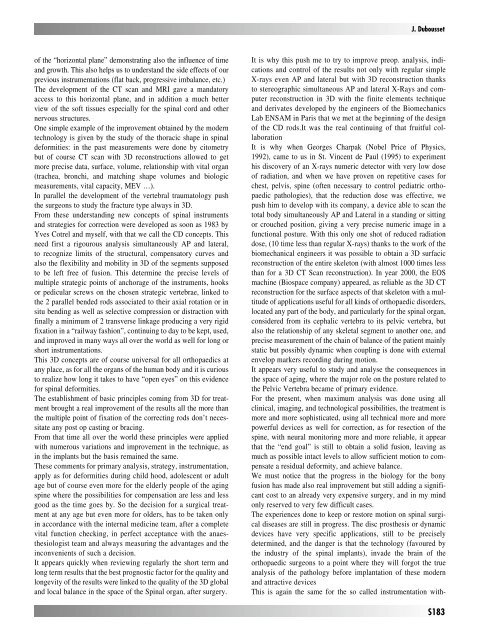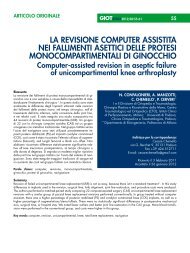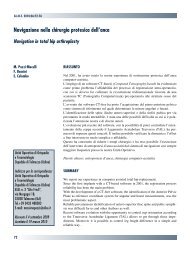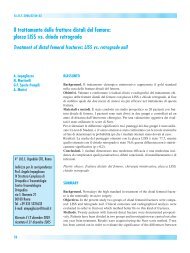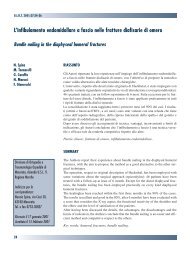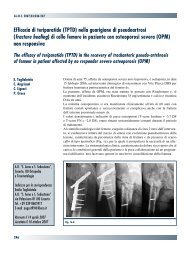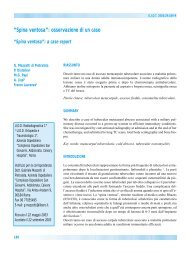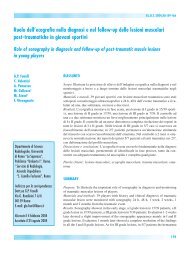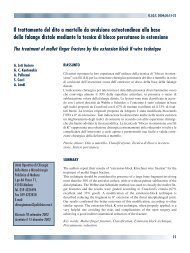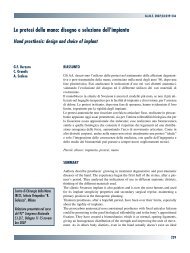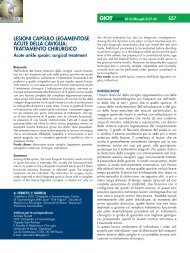30845 Suppl Giot.pdf - Giornale Italiano di Ortopedia e Traumatologia
30845 Suppl Giot.pdf - Giornale Italiano di Ortopedia e Traumatologia
30845 Suppl Giot.pdf - Giornale Italiano di Ortopedia e Traumatologia
You also want an ePaper? Increase the reach of your titles
YUMPU automatically turns print PDFs into web optimized ePapers that Google loves.
of the “horizontal plane” demonstrating also the influence of time<br />
and growth. This also helps us to understand the side effects of our<br />
previous instrumentations (flat back, progressive imbalance, etc.)<br />
The development of the CT scan and MRI gave a mandatory<br />
access to this horizontal plane, and in ad<strong>di</strong>tion a much better<br />
view of the soft tissues especially for the spinal cord and other<br />
nervous structures.<br />
One simple example of the improvement obtained by the modern<br />
technology is given by the study of the thoracic shape in spinal<br />
deformities: in the past measurements were done by citometry<br />
but of course CT scan with 3D reconstructions allowed to get<br />
more precise data, surface, volume, relationship with vital organ<br />
(trachea, bronchi, and matching shape volumes and biologic<br />
measurements, vital capacity, MEV …).<br />
In parallel the development of the vertebral traumatology push<br />
the surgeons to study the fracture type always in 3D.<br />
From these understan<strong>di</strong>ng new concepts of spinal instruments<br />
and strategies for correction were developed as soon as 1983 by<br />
Yves Cotrel and myself, with that we call the CD concepts. This<br />
need first a rigourous analysis simultaneously AP and lateral,<br />
to recognize limits of the structural, compensatory curves and<br />
also the flexibility and mobility in 3D of the segments supposed<br />
to be left free of fusion. This determine the precise levels of<br />
multiple strategic points of anchorage of the instruments, hooks<br />
or pe<strong>di</strong>cular screws on the chosen strategic vertebrae, linked to<br />
the 2 parallel bended rods associated to their axial rotation or in<br />
situ ben<strong>di</strong>ng as well as selective compression or <strong>di</strong>straction with<br />
finally a minimum of 2 transverse linkage producing a very rigid<br />
fixation in a “railway fashion”, continuing to day to be kept, used,<br />
and improved in many ways all over the world as well for long or<br />
short instrumentations.<br />
This 3D concepts are of course universal for all orthopae<strong>di</strong>cs at<br />
any place, as for all the organs of the human body and it is curious<br />
to realize how long it takes to have “open eyes” on this evidence<br />
for spinal deformities.<br />
The establishment of basic principles coming from 3D for treatment<br />
brought a real improvement of the results all the more than<br />
the multiple point of fixation of the correcting rods don’t necessitate<br />
any post op casting or bracing.<br />
From that time all over the world these principles were applied<br />
with numerous variations and improvement in the technique, as<br />
in the implants but the basis remained the same.<br />
These comments for primary analysis, strategy, instrumentation,<br />
apply as for deformities during child hood, adolescent or adult<br />
age but of course even more for the elderly people of the aging<br />
spine where the possibilities for compensation are less and less<br />
good as the time goes by. So the decision for a surgical treatment<br />
at any age but even more for olders, has to be taken only<br />
in accordance with the internal me<strong>di</strong>cine team, after a complete<br />
vital function checking, in perfect acceptance with the anaesthesiologist<br />
team and always measuring the advantages and the<br />
inconvenients of such a decision.<br />
It appears quickly when reviewing regularly the short term and<br />
long term results that the best prognostic factor for the quality and<br />
longevity of the results were linked to the quality of the 3D global<br />
and local balance in the space of the Spinal organ, after surgery.<br />
J. Dubousset<br />
It is why this push me to try to improve preop. analysis, in<strong>di</strong>cations<br />
and control of the results not only with regular simple<br />
X-rays even AP and lateral but with 3D reconstruction thanks<br />
to stereographic simultaneous AP and lateral X-Rays and computer<br />
reconstruction in 3D with the finite elements technique<br />
and derivates developed by the engineers of the Biomechanics<br />
Lab ENSAM in Paris that we met at the beginning of the design<br />
of the CD rods.It was the real continuing of that fruitful collaboration<br />
It is why when Georges Charpak (Nobel Price of Physics,<br />
1992), came to us in St. Vincent de Paul (1995) to experiment<br />
his <strong>di</strong>scovery of an X-rays numeric detector with very low dose<br />
of ra<strong>di</strong>ation, and when we have proven on repetitive cases for<br />
chest, pelvis, spine (often necessary to control pe<strong>di</strong>atric orthopae<strong>di</strong>c<br />
pathologies), that the reduction dose was effective, we<br />
push him to develop with its company, a device able to scan the<br />
total body simultaneously AP and Lateral in a stan<strong>di</strong>ng or sitting<br />
or crouched position, giving a very precise numeric image in a<br />
functional posture. With this only one shot of reduced ra<strong>di</strong>ation<br />
dose, (10 time less than regular X-rays) thanks to the work of the<br />
biomechanical engineers it was possible to obtain a 3D surfacic<br />
reconstruction of the entire skeleton (with almost 1000 times less<br />
than for a 3D CT Scan reconstruction). In year 2000, the EOS<br />
machine (Biospace company) appeared, as reliable as the 3D CT<br />
reconstruction for the surface aspects of that skeleton with a multitude<br />
of applications useful for all kinds of orthopae<strong>di</strong>c <strong>di</strong>sorders,<br />
located any part of the body, and particularly for the spinal organ,<br />
considered from its cephalic vertebra to its pelvic vertebra, but<br />
also the relationship of any skeletal segment to another one, and<br />
precise measurement of the chain of balance of the patient mainly<br />
static but possibly dynamic when coupling is done with external<br />
envelop markers recor<strong>di</strong>ng during motion.<br />
It appears very useful to study and analyse the consequences in<br />
the space of aging, where the major role on the posture related to<br />
the Pelvic Vertebra became of primary evidence.<br />
For the present, when maximum analysis was done using all<br />
clinical, imaging, and technological possibilities, the treatment is<br />
more and more sophisticated, using all technical more and more<br />
powerful devices as well for correction, as for resection of the<br />
spine, with neural monitoring more and more reliable, it appear<br />
that the “end goal” is still to obtain a solid fusion, leaving as<br />
much as possible intact levels to allow sufficient motion to compensate<br />
a residual deformity, and achieve balance.<br />
We must notice that the progress in the biology for the bony<br />
fusion has made also real improvement but still ad<strong>di</strong>ng a significant<br />
cost to an already very expensive surgery, and in my mind<br />
only reserved to very few <strong>di</strong>fficult cases.<br />
The experiences done to keep or restore motion on spinal surgical<br />
<strong>di</strong>seases are still in progress. The <strong>di</strong>sc prosthesis or dynamic<br />
devices have very specific applications, still to be precisely<br />
determined, and the danger is that the technology (favoured by<br />
the industry of the spinal implants), invade the brain of the<br />
orthopae<strong>di</strong>c surgeons to a point where they will forgot the true<br />
analysis of the pathology before implantation of these modern<br />
and attractive devices<br />
This is again the same for the so called instrumentation with-<br />
S183


